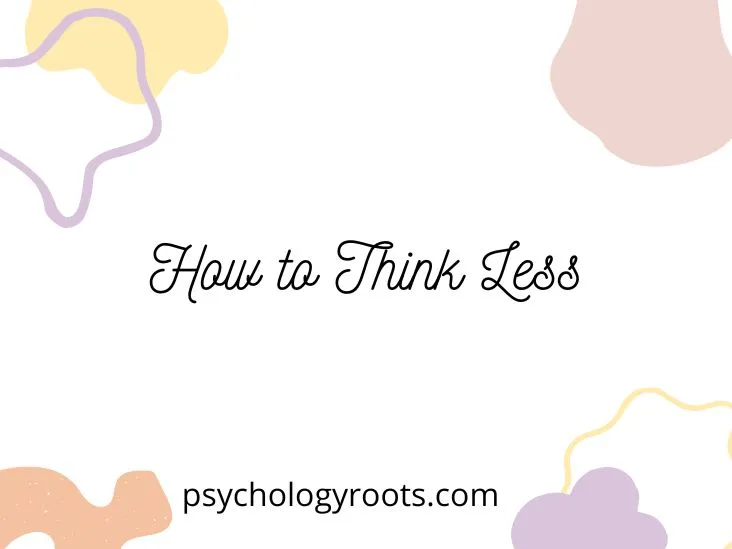Table of Contents
How to Think Less
Here in this post, we are discussing “How to Think Less”. You can read more about psychology-related material on our website. Keep visiting Psychology Roots.
It’s generally because my mind is racing with ideas that I find myself unable to fall asleep. I’m sure you can sympathise. I go through my mental closets, pulling out every last anxiety I have. Next thing I know, I’m anxious about being unable to sleep. I often find myself wishing, “I wish I could simply stop thinking.”
Unfortunately, the more you attempt to silence your mind, the more insistent it becomes. Just as stating to yourself “stop thinking about your big toe” makes your big toe tingle, attempting to “not think” makes you think more.

How to Think Less
The Low Point
It’s likely not what you’ve attempted, but there is a method to not think, or at least to discover areas without thinking. For the podcast Your Life in Process, I recently spoke with Dr. Steven Hayes, one of the original developers of Acceptance and Commitment Therapy (ACT). Dr. Hayes, author of 670 scholarly publications and 47 books, is an authority in assisting people in detaching themselves from their ideas in order to lead more meaningful lives.
His advice for me? Find the flat area between your ideas. If you pay attention to your mind you will notice:
- One, you have thoughts in your head. They just keep piling up like a mountain of dirty clothes!
- Second, there is a level of nothingness between the moment an idea first forms in your head and the moment it disappears.
There is “no object” in the blank space between our brain’s conscious and subconscious processes. It’s like the moments between your inhale and exhale when your breath merely lingers, or the time before you act on your need. The flat spot is a pause in thinking and doing.
When describing the time between a stimulus and an individual’s reaction, Victor Frankl used a similar phrase. Pema Chödrön, a Buddhist nun, refers to this void as “nothing-ness.”
No-Thing-Ness
You may locate this place of “no-thing” by paying less attention to the gap between your ideas. Don’t dwell on the specifics of your thoughts (what if I can’t sleep?!), but rather, observe the empty space between them. Much like a photographer who pays attention to the backdrop as much as the foreground, search for the background of your thoughts and scan for a moment, no matter how short, when there is no thought. A level area.
Cognitive defusion is the process of taking a step back from the meaning of one’s ideas in this manner, as used by ACT therapists.
This flat region feels surprisingly soothing. What you think is not the same thing as who you are. There is always a moment to pause your thoughts, no matter how hectic your brain may be. From my perspective as a native Californian, it reminds me of the stillness and calmness of the ocean just before a wave rises and smashes against the coast.
This flat spot practise may also be used to interpersonal interactions, daily stresses, persistent discomfort, and compulsive habits.
- Can you locate a flat zone when you aren’t brooding over your divorce?
- Is there a low point when you don’t feel the need to utilise drugs or alcohol?
- When your inner critic is silent, do you hit a plateau?
- Do you ever hit a lull in your workout when everything just flows smoothly?
Instead than trying to force it, focus on it.
It’s possible that once you start looking for them, you’ll find them absolutely everywhere. And the more you seek for them, the longer they appear to endure. If you can learn to recognise these lulls in your thinking, you may find relief from even the most distressing or lingering ideas.
Dr. Hayes explained to me that attempting to force or manufacture flat places is different from just discovering them. We can’t send them any farther than they’ve already gone. Just like you can’t make the water stop making waves, you can’t make yourself stop thinking. Making an effort to reduce your mental activity actually increases it. The empty spaces in your mind, though, may be a haven of calm. As a matter of fact, if you stay in one of these positions for too long, you could even nod off.
Summary
There is a method to not think – or at least to discover areas without thinking. Dr. Steven Hayes, one of the original developers of Acceptance and Commitment Therapy (ACT) explains how. Find the flat area between your ideas and observe the empty space between them. Cognitive defusion is the process of taking a step back from the meaning of one’s ideas in this manner, as used by ACT therapists. There is always a moment to pause your thoughts, no matter how hectic your brain may be. The more you seek for them, the longer they appear to endure.
Help Us Improve This Article
Have you discovered an inaccuracy? We put out great effort to give accurate and scientifically trustworthy information to our readers. Please notify us if you discover any typographical or grammatical errors.
Make a comment. We acknowledge and appreciate your efforts.
If you have any scale or any material related to psychology kindly share it with us at psychologyroots@gmail.com. We help others on behalf of you.